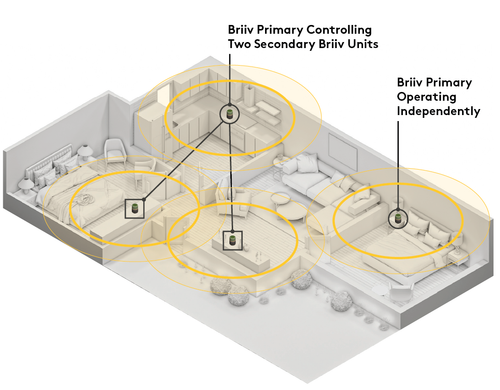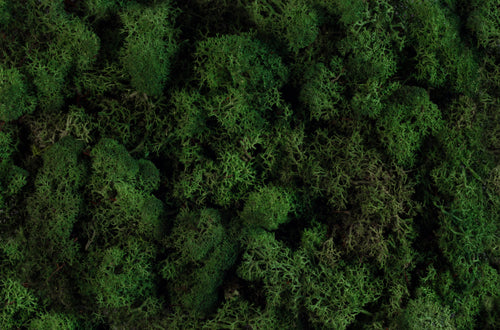
Briiv Pro vs. Smoke
Share
Fun With Metal
Back in December we started machining the electrodes that are going to be used to spark erode the tool for injection moulding. These pieces of copper will slowly sink into the metal of the tool over a couple of days to create the intricate negative shapes that form the base of Briiv Pro.
Particularity challenging are the fins of Briiv Pro. Designed to be thin and non-obstructive to the air flow, this also makes them very thin and intricate to machine.

This is one of the first stages in the tooling process and also a very satisfying one, as it's the first glimpse of how Briiv Pro will look formed out of a special grade of solid copper!
How Is 'Stuff' From The Air Captured By Briiv?
We get asked this a LOT, and we've had a quite a few private messages about how Briiv Pro captures dust and other nasty things.
The filters are designed to capture particles in the air through a series of physical and mechanical processes. Here's a list of some of those processes.
1. Filter Structure
The filters consist of a dense arrangement of randomly arranged fibres that create a labyrinth path for air to flow through.
2. Interception
Larger particles are captured through a process called interception. As air flows through the filter these particles, due to their size and inertia, are unable to navigate through the fibres and instead collide with and stick to the fibres. This happens mostly in the moss layer.
3. Impaction
Medium-sized particles follow the air stream but, due to their inertia, are unable to adjust quickly to the air flow direction changes caused by the fibres. This causes them to impact and get stuck to the fibres. This happens mostly in the coconut layer.
4. Diffusion
Smaller particles, influenced by Brownian motion (random movement of particles in the air), are more likely to collide with and be captured by much finer filter fibres. This is happening mostly in the final matrix layers of Briiv Pro.
5. Sieving
The dense arrangement of fibres acts as a sieve, effectively capturing particles of various sizes as they attempt to pass through the filter.
6. Electrostatic build up
The final layer uses a glass fibre as the base material. This builds up an electrostatic charge as the air passes through it. This action then acts like a magnet pulling particulates onto and into the filter as it passes through it.
What Actually Is PM2.5 And PM10?
For the terms "PM2.5 & PM10," the "PM" stands for Particulate Matter.
PM2.5 specifically refers to particulate matter that has a diameter of 2.5 micrometers or smaller. These particles can include a variety of substances such as dust, mould, and fine particulates from combustion sources like vehicle emissions and industrial processes. Monitoring PM2.5 levels is important for assessing air quality, as these fine particles can penetrate deep into the respiratory system and have potential negative health implications.
PM10 refers to particulate matter with a diameter of 10 micrometers or smaller. Like PM2.5, PM10 includes a range of particles of different sizes, including dust, pollen, mould, and particles from combustion sources. PM10 particles are larger than PM2.5 but still small enough to be inhaled.
Regulatory agencies and environmental monitoring programs often measure both PM2.5 and PM10 to evaluate air quality.
Air quality sensors will often have these measurements shown so that they can be compared to a long standing, tried and tested level of what is considered a safe amount of each and then give visual feedback, so people to know when their air is not safe.
Follow ups to this question are often how small is pollen? or what filters capture smoke?
To put something complicated into much simpler terms, we went away and created the table below. This is a general rule for the entire air purification industry and shows the pollutant, it's size range and what is required to capture it.

How Does Briiv Pro Stand Up To All This?
Briiv is tested based on the size of particles. Formaldehyde for example is incredibly tiny, smaller than 0.1 micron! Pollen particles on the other hand average about 25 microns.
Briiv pro has been tested with industry standard sensors, using PM2.5 and PM10 as the main testing metrics, and that is what is shown in the graphs on the campaign page.
Briiv is able to reliably capture particles as small as 2.5 microns. Smaller than that, particles behave much more erratically so it's harder to guarantee they'll all be removed, but Briiv does have the capacity to remove particles as small as 0.3 microns from the air.
Testing Cigarette Smoke In The Real World
Cigarette smoke can be a real problem for enclosed spaces as it lingers for a very long time. If you've ever lived in an apartment you'll also be very aware when your neighbours are smoking as it can permeate walls and travel a very long way within buildings.
We wanted to do a real rough and ready but very visual test for you guys so you could see what Briiv Pro is capable of. As you can see, it clears the smoke from an entire cigarette in around 10 seconds in our test tank!
We hope this was interesting and useful. If you have any questions, as always feel free to reach out to me and I will be happy to help.
Related Posts
-

How Can We Use Earth’s Resources Sustainably?
Utilising Earth’s natural resources is essential for human wellbeing and development. From building materials to ener...
-

At Home With Nature: What is Biophilic Design, and How Can I Incorporate It Into My Space?
What is biophilic design? Biophilic design is the principle of incorporating nature into the design process and style...
-

How to Improve Cognitive Function and Avoid Sick Building Syndrome
When self-reflecting and looking for self-improvement, considering your cognitive function can be a great place to st...
-

Going for Gold
Fun With Fans Back in May we had all of the fans that live within Briiv Pro arrive and apart from a fright we had wh...
-

Save Money, Live Sustainably: Practical Tips for an Eco-Conscious Lifestyle
In today’s world it feels like there are a million ways to be more ethical in our purchases, which feels like a milli...
-

Christmas Shipping 2024
Hi everyone, As we close in on the end of the year, we've listed below the advisory last posting dates for Briiv: ...
-

Briiv Fragrances; add fragrance to your home with new Briiv essential oils
Briiv 2 and Briiv 2 Pro have a built-in fragrance diffuser, so that after the harmful pollutants have been removed fr...
-

How to Get a Better Night’s Sleep
A good night of sleep is crucial to support your health and wellbeing. While a one-off late night or restless evening...
-

How to build a Briiv System
With Briiv 2 Pro you can build a mesh network of small and powerful air purifiers that work in unison to automaticall...
-

How Air Purifiers Can Help Remove Smoke and Odours During BBQ Season
As the weather continues to get warmer there’s nothing better than getting outside and cranking on the BBQ, but while...
-

How to Save Energy: Tips for Reducing Your Consumption and Bills
We all know how important it is to save energy; from cutting down on your bills to reducing fossil fuel emissions, en...
-

How To Measure Your Space for an Air Purifier
In the world of air purifiers (and trust us, it’s a pretty extensive world) it can be overwhelming to decide what’s r...
-

Behind Briiv Pro
Prototyping And Designing The Electronics We wanted to share some behind the scenes of developing the electronics tha...
-

Smelling Great
A Close Look At The New Briiv Aroma We have had a few questions about how the fragrance part works in Briiv Pro, so...
-

Pollen Protection: How Air Purifiers Can Help You Survive Allergy Season
It’s that time of year; the sun is starting to show itself, we’re creeping into Spring, and we’re stocking up on anti...
-

How To Freshen Up Your Home
As the days are getting longer and the weather’s improving, we really are finally saying goodbye to Winter. And what ...
-

Aerosols: What are they, where are they from and where do they go?
Aerosols are everywhere in today’s world; be it your morning deodorant and a spritz of hairspray, or your everyday ai...
-

Will an Air Purifier Improve My Health?
There are plenty of reasons you’d want to bring an air purifier into your life, whether you’re wanting to remove unpl...
-

Welcome to Briiv Pro!
As it's our second time on Kickstarter, we're looking to do things a little different through this campaign and want ...
-

Christmas Shipping 2023
Hi everyone, As we close in on the end of the year, we've listed below the advisory last posting dates for Briiv: In...
-

Briiv Pro has Launched!
For a while now we've been exploring how to improve Briiv. With amazing feedback from our customers and community, al...
-

We Partnered with airQ
We recently partnered with the air quality monitor, airQ, to see how Briiv performed in a unique test environment. Br...
-

What's the deal with ozone?
With enough fear mongering online, it's understandable why you'd want to make sure your air purifier isn't actually ...
-

Caring for Briiv
Look after your Briiv so it can keep on looking after you. Your Briiv requires little to no maintenance, unlike s...
-

A Multi-Award Wining Product
Read what the experts have to say here! The idea of Briiv was born in 2019, and in the 4 years since then it's p...
-

Let's Get Social!
Whether you're into social media or not, you can benefit from learning a bit more about your favourite brands on diff...
-

Allergies? We're All-over it!
Briiv can be your shield against a season of sniffles! It's allergy season and if you're a sufferer, you know exa...
-

The Briiv Story (So Far!)
We’re all so proud here at Briiv of how far we’ve come over the past few years that we decided to take a look back at...
-

Briiv App: Trials and Tribulations
I wanted to just take some time and run through the challenges we have had and why it has taken us so long to get th...
-

Eco Excellence Awards 2022
We’re so excited to share that we recently won not one, but two Eco-Excellence Awards in the Home Air Purifier catego...
-

B Corp Certified
As of August 2022, we are incredibly proud to say that Briiv is B Corporation certified! As a B Corp business, Briiv ...
-

Solar Impulse Efficient Solution Label
The Solar Impulse foundation has collected over 1,000 clean and profitable solutions, and now Briiv is one of them. W...
-

A Year in Review
Hello everyone! As we look back on the year, any attempt to sum it all up will be an understatement to say the least....
-

Briiv Goes to the P.E.A. Awards
This past weekend, we attended the P.E.A. Awards in Marylebone, London, the UK’s leading sustainability awards. The G...
-

Embracing The Circular Economy and Designing Towards a Greener Planet: The Briiv Story So Far
Photo by Elena Mozhvilo on Unsplash The world we live in is filled with infinite wonder and incredible beauty, but ...
-

Fulfilment Plans & New Branding
Fulfilment Plans & New Branding Hello everyone! We're thrilled this month to be able to bring you news, that...
-

Production Update - June 2021
Hello everyone, It's time for our monthly update and you'll be thankful to hear the updated timelines we set ou...
-

The A' Design award
More Outstanding Recognition for briiv We are thrilled to announce we are the recipients of yet another prestigious d...
-

Red dot winner 2021
Award-Winning We're extremely excited to share the news that this last month, we won an award for the briiv Air Filte...
-

We're on track! / Carbon Neutral
Hello everyone, Production Update We hope you are all keeping safe and well. It's been a month since our last up...
-

Manufacturing Update - December
Hey everyone, We hope you are all well and want to say thank you for all your messages and support recently. We'...
-

Inside Story, Production Update
Hey everyone! It's been a great few weeks for us as we begin to put into action our production schedule! We have a fe...
-

Plants. Do they actually clean my homes air?
Hi everyone! We're fast approaching the end of our Kickstarter campaign and we've really enjoyed your feedback and an...











































